
Utah
Utah: Who Pays? 7th Edition
January 9, 2024 • By ITEP Staff
Utah Download PDF All figures and charts show 2024 tax law in Utah, presented at 2023 income levels. Senior taxpayers are excluded for reasons detailed in the methodology. Our analysis includes nearly all (99.5 percent) state and local tax revenue collected in Utah. State and local tax shares of family income Top 20% Income Group […]
Voices for Utah Children: Response to Govenor’s Budget Recommendations FY2020
December 17, 2018
As a percent of income, 95% of Utah’s families pay more in sales and other local taxes than the top 5% of higher income families.
FOX13 SLC: Middle Income Utahns Bear Brunt of State and Local Tax Burden
October 19, 2018
The Institute on Taxation and Economic Policy released a report showing how every state and the District of Columbia use tax policy in regressive and progressive ways. Their conclusion: all but five states and the District of Columbia have regressive systems, meaning they favor the wealthy over middle and/or low-income earners.
Utah: Who Pays? 6th Edition
October 17, 2018 • By ITEP Staff

UTAH Read as PDF UTAH STATE AND LOCAL TAXES Taxes as Share of Family Income Top 20% Income Group Lowest 20% Second 20% Middle 20% Fourth 20% Next 15% Next 4% Top 1% Income Range Less than $22,900 $22,900 to $39,600 $39,600 to $63,900 $63,900 to $104,300 $104,300 to $202,400 $202,400 to $486,500 over $486,500 […]
Tax Cuts 2.0 – Utah
September 26, 2018 • By ITEP Staff
The $2 trillion 2017 Tax Cuts and Jobs Act (TCJA) includes several provisions set to expire at the end of 2025. Now, GOP leaders have introduced a bill informally called “Tax Cuts 2.0” or “Tax Reform 2.0,” which would make the temporary provisions permanent. And they falsely claim that making these provisions permanent will benefit […]
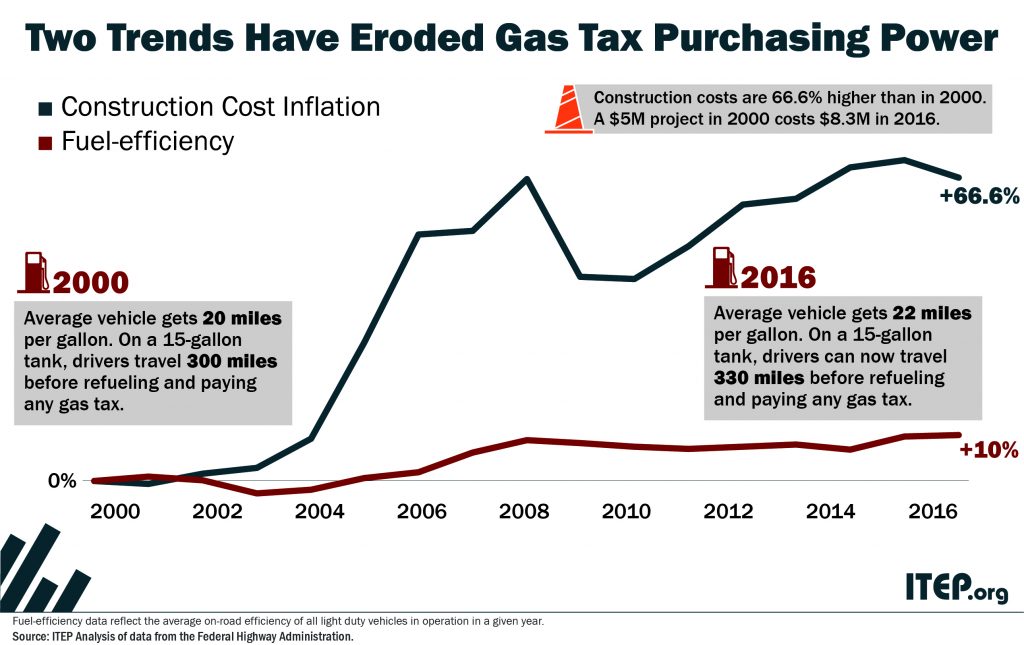
An updated version of this blog was published in April 2019. State tax policy can be a contentious topic, but in recent years there has been a remarkable level of agreement on one tax in particular: the gasoline tax. Increasingly, state lawmakers are deciding that outdated gas taxes need to be raised and reformed to fund infrastructure projects that are vital to their economies.
How the Final GOP-Trump Tax Bill Would Affect Utah Residents’ Federal Taxes
December 16, 2017 • By ITEP Staff
The final tax bill that Republicans in Congress are poised to approve would provide most of its benefits to high-income households and foreign investors while raising taxes on many low- and middle-income Americans. The bill would go into effect in 2018 but the provisions directly affecting families and individuals would all expire after 2025, with […]
How the House and Senate Tax Bills Would Affect Utah Residents’ Federal Taxes
December 6, 2017 • By ITEP Staff
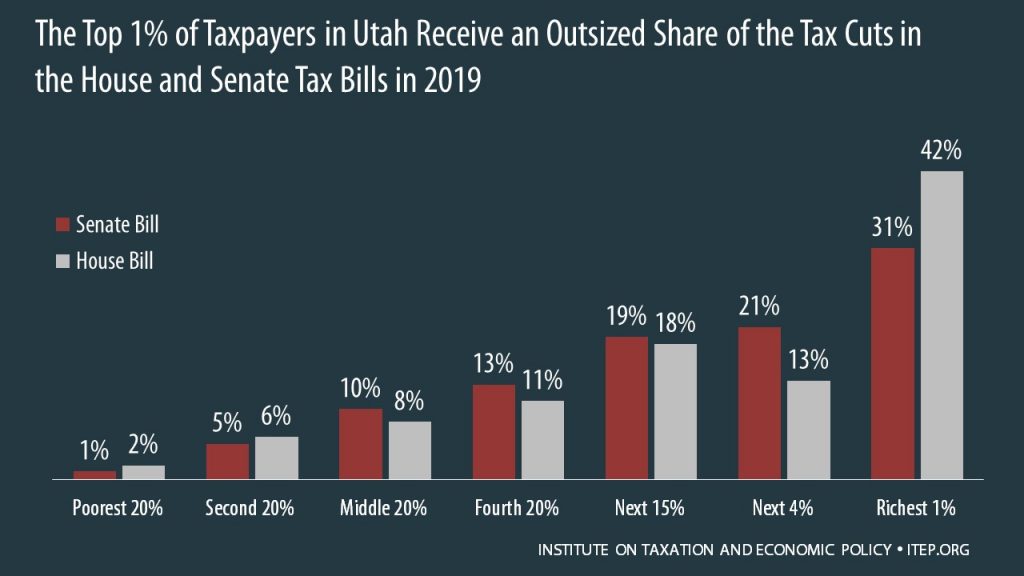
The House passed its “Tax Cuts and Jobs Act” November 16th and the Senate passed its version December 2nd. Both bills would raise taxes on many low- and middle-income families in every state and provide the wealthiest Americans and foreign investors substantial tax cuts, while adding more than $1.4 trillion to the deficit over ten years. The graph below shows that both bills are skewed to the richest 1 percent of Utah residents.
How the Revised Senate Tax Bill Would Affect Utah Residents’ Federal Taxes
November 14, 2017 • By ITEP Staff
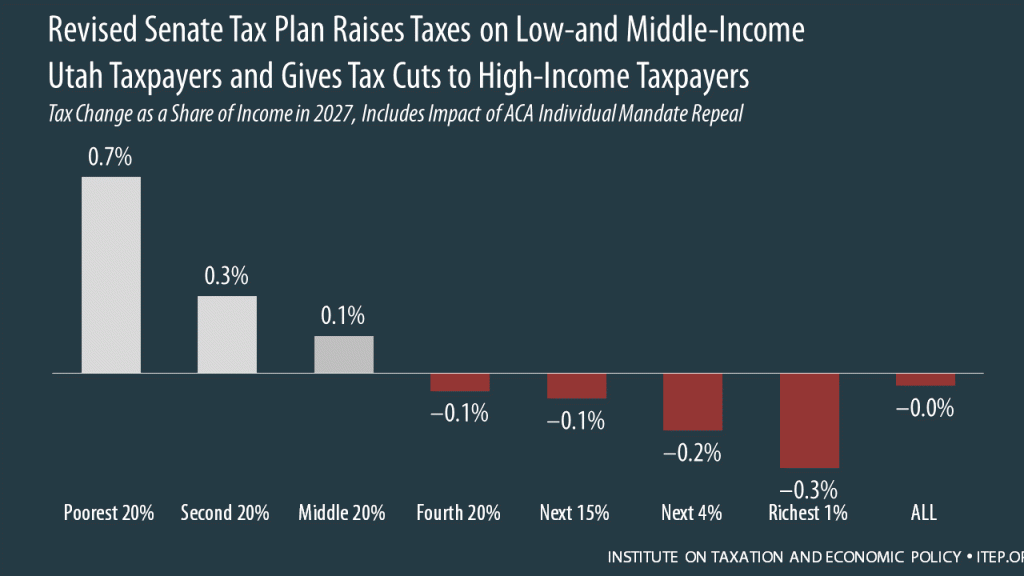
The Senate tax bill released last week would raise taxes on some families while bestowing immense benefits on wealthy Americans and foreign investors. In Utah, 58 percent of the federal tax cuts would go to the richest 5 percent of residents, and 18 percent of households would face a tax increase, once the bill is fully implemented.
How the House Tax Proposal Would Affect Utah Residents’ Federal Taxes
November 6, 2017 • By ITEP Staff
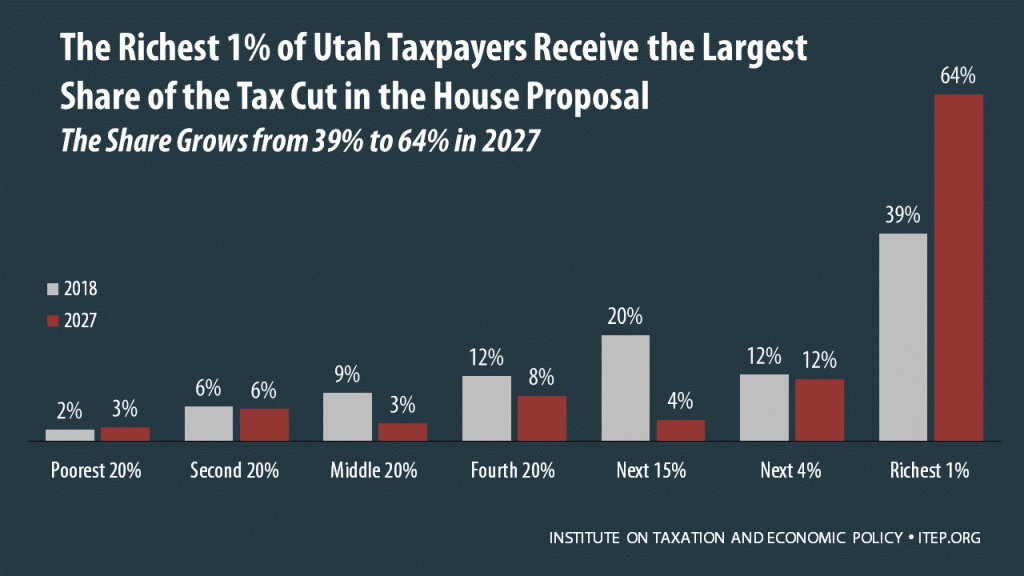
The Tax Cuts and Jobs Act, which was introduced on November 2 in the House of Representatives, includes some provisions that raise taxes and some that cut taxes, so the net effect for any particular family’s federal tax bill depends on their situation. Some of the provisions that benefit the middle class — like lower tax rates, an increased standard deduction, and a $300 tax credit for each adult in a household — are designed to expire or become less generous over time. Some of the provisions that benefit the wealthy, such as the reduction and eventual repeal of the estate…
GOP-Trump Tax Framework Would Provide Richest One Percent in Utah with 78.9 Percent of the State’s Tax Cuts
October 4, 2017 • By ITEP Staff

The “tax reform framework” released by the Trump administration and congressional Republican leaders on September 27 would not benefit everyone in Utah equally. The richest one percent of Utah residents would receive 78.9 percent of the tax cuts within the state under the framework in 2018. These households are projected to have an income of at least $545,500 next year. The framework would provide them an average tax cut of $82,990 in 2018, which would increase their income by an average of 5.3 percent.
In Utah 41.9 Percent of Trump’s Proposed Tax Cuts Go to People Making More than $1 Million
August 17, 2017 • By ITEP Staff
A tiny fraction of the Utah population (0.3 percent) earns more than $1 million annually. But this elite group would receive 41.9 percent of the tax cuts that go to Utah residents under the tax proposals from the Trump administration. A much larger group, 41.0 percent of the state, earns less than $45,000, but would receive just 5.3 percent of the tax cuts.
Trump Tax Proposals Would Provide Richest One Percent in Utah with 65.5 Percent of the State’s Tax Cuts
July 20, 2017 • By ITEP Staff
Earlier this year, the Trump administration released some broadly outlined proposals to overhaul the federal tax code. Households in Utah would not benefit equally from these proposals. The richest one percent of the state’s taxpayers are projected to make an average income of $1,573,600 in 2018.
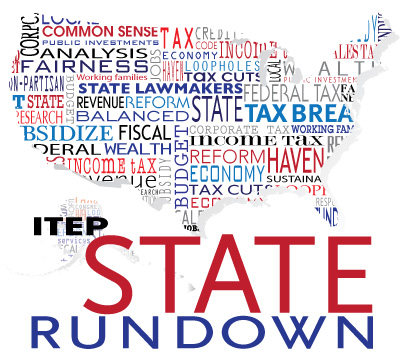
This week, we celebrate a victory in Kansas where lawmakers rolled back Brownback's tax cuts for the richest taxpayers. Governors in West Virginia and Alaska promote compromise tax plans. Texas heads into special session and Vermont faces another budget veto, while Louisiana and New Mexico are on the verge of wrapping up. Voters in Massachusetts may soon be able to weigh in on a millionaire's tax, the California Senate passed single-payer health care, and more!
Deseret News: Child tax credit
January 9, 2017
“Also, the increase in income tax for large families would mostly negatively impact lower-income families, who according to an Institute on Taxation and Economic Policy report are already paying a higher percentage of their income for state and local taxes than the upper 20 percent.” Read more
Salt Lake Tribune: Worried about filing taxes? You have three extra days
April 15, 2016
“The Institute on Taxation and Economic Policy earlier this year issued a state-by-state report looking at what percentage of the income of various groups goes to state and local taxes.” Read more
Salt Lake Tribune: Editorial: Lotteries hurt the poor, but not as badly as Utah’s tax system
January 19, 2016
“Arguably, it isn’t as bad here as it is in some other states. Last year, an outfit called the Institute on Taxation and Economic Policy, which worries about financial inequality, ran some numbers and determined that, out of 50 states, Utah’s tax policy was the 34th most regressive. That is, 33 states were worse than […]
State Tax Notes: States Increase Gas Tax in Push for Transportation Funds
July 13, 2015
In the absence of a national gasoline tax increase, states have been raising their gas taxes to fund long-deferred road maintenance and transportation projects. “I think what’s happening now is a lot of states are having to play catch-up. They let their infrastructure deteriorate to a point where it’s an issue that can’t be ignored […]
TI News Daily: Some States Prefer Transportation Over Tax relief
July 8, 2015
To meet infrastructure needs, several states have had to increase other taxes, such as gasoline taxes. These states include Idaho, Iowa, Georgia, Nebraska, North Carolina, Kentucky, Utah and South Dakota. Four of these states are currently finalizing infrastructure funding increases or are still discussing infrastructure funding raises. “A lot of states realized they couldn’t put […]
The Salt Lake Tribune: Utah’s tax burden hits 20-year low, rich-poor gap widens
January 16, 2015
“Utah’s tax burden is at its lowest point in 20 years. But poor and middle-class Utahns pay nearly twice as much of their earnings for tax as do the wealthiest 1 percent. That is according to two reports released Wednesday, one by the Utah Foundation and the other by the Institute on Taxation and Economic […]
KSL: Utah’s tax burden at 20-year low
January 15, 2015
“A separate report released Wednesday by the Institute on Taxation and Economic Policy showed that Utah’s tax system, like those of most other states, follows a regressive model, where families of lower incomes are taxed a larger share of their earnings than wealthier families. That isn’t so for the personal income tax, which is more […]
Mint Press News: Low Oil Prices Prompt New Interest In Raising Gas Tax, Cutting Subsidies
January 15, 2015
“Utah has gone almost 18 years without an increase in its gas tax, so instead they’ve increasingly spent money from their General Fund on transportation – spending less on education and human services,” Carl Davis, a senior analyst at the Institute on Taxation and Economic Policy (ITEP), told MintPress News. Yet Davis notes that thinking […]
Utah Foundation: Fueling Our Future, 2013-2040
March 20, 2013
Policy Options to Address Utah’s Future Transportation Needs Funding Utah’s transportation needs is a significant economic and fiscal challenge for state policymakers. Over the next three decades, Utah’s population is set to increase by over 60% from 2.8 million to 4.5 million.1 Coupled with this signifi cant growth is the possibility of an increase in […]
Voices for Utah Children: Analysis of a Three-Part Proposal to Reform Utah’s Sales Tax
January 31, 2013
A proposal that will be discussed during the 2013 General Session would return Utah’s state sales tax on groceries to the general sales tax rate, while offering two kinds of tax credits to mitigate the negative impacts on vulnerable households. A detailed economic analysis from the Institute on Taxation and Economic Policy (ITEP), a non-partisan […]
Deseret News: Current cuts won’t get Utah through 2011
January 8, 2013
(PDF of Original Post) Down-to-the-bone look at taxes called a necessityBy James Thalman Deseret NewsPublished: Friday, Nov. 27, 2009 4:39 p.m. MST Cutbacks in agency budgets have so far helped Utah handle a tax-revenue pinch, but they won’t do much to get through the blockage awaiting in 2011, local and national budget-policy analysts say. A […]
